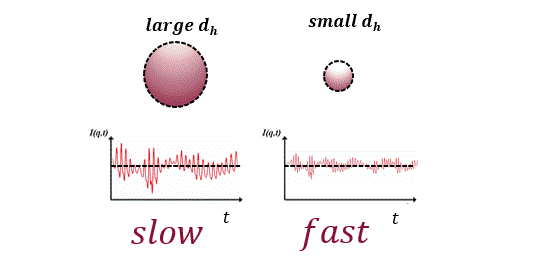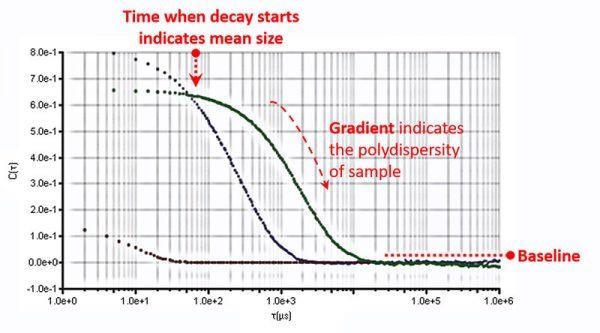
Image Credit: Brookhaven Instrument Corporation
Dynamic Light Scattering (DLS) is a measurement method that offers a quick and easy technique for the sizing of submicron and nanoparticle.
Theoretical Basis for Light Scattering
Light scattering is something that can be seen when light, typically monochromatic laser light, is scattered by objects oriented at random in solution. Inhomogeneities cause scattered light; in a uniform continuum, there would not be any deflection of the path of laser light as it moves through a medium. The strength of light scattered is relative to size, molecular weight and the variation in refractive index (Δn) across the scattering center (nsample) and solvent (nsolvent). Provided Δn is nonzero, light scattering should take place.
Dynamic vs. Static Light Scattering
Commercially available light scattering instruments usually take advantage of one of two fundamental values to obtain data from this scattered light. Static Light Scattering (SLS) needs very precise photon counting, resulting in the magnitude of the scattered light becoming the most essential parameter. This technique is employed to achieve parameters like Mw, Rg and A2. By comparison, Dynamic Light Scattering (DLS) takes advantage of the combined motion of a great group of randomly oriented particles spread in some medium.
DLS depends on the fact that easily diffusing particles, travelling randomly because of Brownian motion, will result in quick variations in scattered laser light. Such fluctuations are fast, on the order of tens of nanoseconds to hundreds of milliseconds, and are precisely linked to the motion of particles. Temporal autocorrelation is employed to calculate the speed at which these photo pulses decorrelate from an initial state, which is then connected directly to the movement of particles.
Making a Dynamic Light Scattering Measurement
To record an actual sample employing DLS, the sample must be able to disperse in a solvent. A substantial quantity of attention must be given to planning dust-free solutions, in addition to preventing samples that are too concentrated (e.g., high volume fraction). DLS is meant to be employed in dilute solution circumstances, so it is pertinent to note that not every sample that is quantifiable will automatically be appropriate for analysis.
Difficulty with DLS at high concentration? Explaining this unique problem!
Video Credit: Brookhaven Instrument Corporation
Turning Scattered Light into Particle Size Information
The signal that occurs from the scattered strength from the laser light is amassed and changed into an autocorrelation function which is the foundation for determining a particle size distribution. In this method, fast variations in the concentration of scattered light occur from the random movement of dispersed particles. This random, or Brownian, movement of particles and proteins is examined using autocorrelation to offer either a simple mean size and polydispersity, or more comprehensive distribution data including for multimodal deliveries.
The diameter achieved from Dynamic Light Scattering is frequently known as the hydrodynamic diameter and is inversely related to the diffusion coefficient. Big particles scatter additional light and diffuse slower than small particles. The hydrodynamic diameter is associated with the diffusion coefficient through the Stokes-Einstein equation, in which size is inverse with the rate of diffusion.

Image Credit: Brookhaven Instrument Corporation
When a distribution of sizes occurs, the efficient diameter measured is a general diameter, which is weighted by the strength of light scattered by every particle. This strength weighting is not the same as the population or number weighting employed in a single particle counter like in electron microscopy. Despite this, even for closely dispersed samples, the average diameters achieved tend to be in good accord with those achieved by single particle methods.
The Stokes-Einstein Equation and Dynamic Light Scattering
The connection between the translational diffusion coefficient Dt, the primary quantity recorded in DLS and hydrodynamic particle size, dh, is inverse and is provided by the Stokes-Einstein Equation:
Dt = Kb T / 3πηdh
When the Boltzmann constant (Kb), Temperature (T) and bulk viscosity (η) are recognized values and only the particle size, dh, is a property of the particle.
For a recognized scattering angle, θ and refractive index, n, the scattering vector q is determined from the following expression where λo is the wavelength of the laser:
q = 4πn/λo sin(θ/2)
A given autocorrelation function (ACF), usually characterized as a function of delay time, C(τ) is deconvoluted into either a single-exponential, stretched-exponential, or sum of exponentials. Where B is a continuous background term and A, an optical constant established by instrument design:
C(τ)=B⋅[1+A⋅exp(-2Γτ)]
The outcome of this deconvolution is a characteristic linewidth or decay rate, Г, and usually a polydispersity index (PDI). Polydispersity indicates the broadness of a provided distribution, which be due to either a single wide population or the coexistence of many discrete populations.
This linewidth, Г, is associated with the translational diffusion coefficient (Dt) as follows:
Г = Dt⋅q2

Image Credit: Brookhaven Instrument Corporation
Dynamic Light Scattering is frequently known as Quasi-Elastic Light Scattering (QELS) or Photo-Correlation Spectroscopy (PCS).
Applications of Dynamic Light Scattering
The most frequent industrial uses of DLS are formulations development and quality control (QC). Many industrial formulations are employed to steady an active component so that it may be stored or delivered; this usually needs surfactants, buffers, viscosity modifiers and polymeric additives.
The aim is to ensure materials remain stable and soluble. The purpose of QC is to identify consistency and, in some certain cases, to identify aggregation or fouling. This method is very similar across a broad range of industries consisting of biopharma, oil recovery, personal care, food formulations, cosmetics and many more.
DLS is also employed in many common R&D activities, including the creation of novel materials, development or screening of new biomolecules, aggregation studies, planning new self-assembled structures, drug delivery and release, nanogels and in researching different exotic surfactant systems.
Dynamic Light Scattering Instruments
There are two usual methods to creating a commercial light scattering instrument. Most will employ either fixed detection angles (cuvettes or flow cells) or will permit for constant rotation of the detector on a rotation stage (goniometer). The NanoBrook series employs fiber optics to offer up to three fixed scattering angles and can hold a cuvette-based sample holder. It is created to be simple to use and applies two of Brookhaven’s core technologies: DLS and Zeta Potential.
Conversely, the BI-200SM Research Goniometer is a c multi-angle instrument and is adequately adaptable to solve a broad variety of research issues. The Research Goniometer is exclusively a DLS and SLS instrument.

This information has been sourced, reviewed and adapted from materials provided by Brookhaven Instrument Corporation.
For more information on this source, please visit Brookhaven Instrument Corporation.